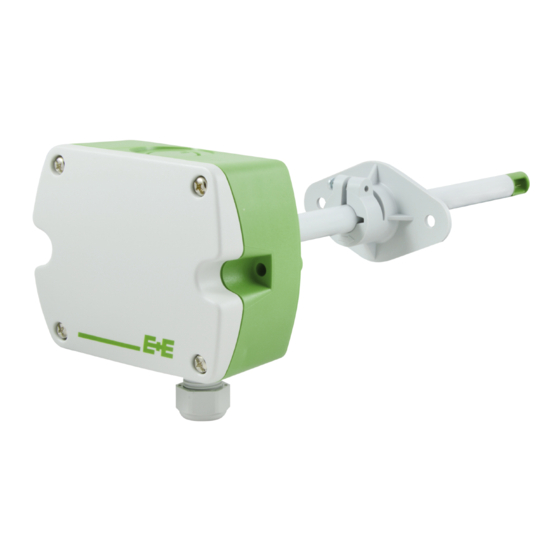
E+E Elektronik EE650 User Manual
Air velocity transmitter for hvac applications
Hide thumbs
Also See for EE650:
- User manual (19 pages) ,
- Quick manual (2 pages) ,
- Quick manual (2 pages)
Advertisement
USER'S GUIDE
EE650 - Air Velocity Transmitter for HVAC Applications
GENERAL
The EE650 transmitter is designed for accurate measurement of air velocity in HVAC. It operates on the hot-film anemometer
principle and features the innovative, very robust E+E VTQ sensing element manufactured in thin-film technology combined with
state-of-the-art transfer molding.
The construction of the sensing head leads to a very low angular dependence which facilitate the installation. The mounting flange
allows for easy adjustment of the immersion depth.
The measuring range and the response time of EE650 can be selected with jumpers on the electronics board, see below
"Settings".
EE650 is dedicated for heating, ventilation and air conditioning applications. For special applications do not hesitate to contact the
manufacturer or their local distributor.
CAUTION
•
Accurate measurement results are conditioned by the correct positioning of the sensing probe in the air stream. Best accuracy
is achieved in laminar flow.
•
Observe the minimum inlet and outlet path length, see page 4.
•
Avoid mechanical stress onto the probe and mainly onto the sensing head.
•
Observe the humidity working range 5...95% RH, non-condensing.
•
Avoid installation in corrosive environment, as this may lead to sensor destruction.
CONNECTING DIAGRAM
Analogue output
Power supply
24 V AC/DC ±20%
1 ... V+ = supply voltage
2 ... GND = ground
3 ... AV = analogue output air velocity
RS485 Interface
Power supply
24 V AC/DC ±20 %
V+
GND
AV
V / mA
~
1
V+
2
GND
A (=D+)
3
RS485
B (=D-)
4
Remote sensor probe
b ... brown
g ... green
y ... yellow
w ... white
s ... black
S1 S2
ON
S1: Response time t
90
ON: slow
OFF: fast
S2: Termination resistor
120 Ohm
ON/OFF
Advertisement
Table of Contents

Summary of Contents for E+E Elektronik EE650
- Page 1 The construction of the sensing head leads to a very low angular dependence which facilitate the installation. The mounting flange allows for easy adjustment of the immersion depth. The measuring range and the response time of EE650 can be selected with jumpers on the electronics board, see below “Settings”.
-
Page 2: Analogue Settings
ANALOGUE SETTINGS For performing EE650 settings via EE-PCS Product Configuration Software (download from www.epluse.com/configurator) the working range jumper must be on HI. Selection of response time t Selection of measuring range Selection of ouput signal Selection of output signal Selection of response time t... -
Page 3: Configuration And Adjustment
CONFIGURATION AND ADJUSTMENT The EE650 as ordered is ready for use immediately and requires no configuration by the user. If required, the optional Configuration Adapter Cable and the E+E Product Configuration Software (EE-PCS) can be used for changing the factory setup as well as for adju- sting of the air velocity measurement. -
Page 4: Technical Data
Mounting flange Ø > 16 Type - Duct mount Cable gland M16x1,5 SCOPE OF SUPPLY • EE650 Transmitter according to ordering guide • Cable gland (two pieces at output RS485 for daisy chain wiring) • Mounting flange • Mounting materials •... - Page 5 EE650 probe, make sure that the arrow matches exactly the flow direction. INCORRECT CORRECT Air flow The mounting flange allows for precise setting of the EE650 immersion depth in a duct. The entire sensing head must be in the air flow to be measured. CORRECT INCORRECT...
- Page 6 POSITIONING OF AIR VELOCITY SENSOR IN A VENTILATION DUCT The reliable and accurate measurement of air velocity depends on the correct positioning of the sensor in the ventilation duct. Accurate measurements are only possible if the air velocity probe is positioned at a location with a laminar (not-turbulent) flow. The required length of the calming section after a fault is a function of the tube diameter D.
- Page 7 E+E Elektronik Ges.m.b.H. doesn‘t accept warranty and liability claims neither upon this publication nor in case of improper treatment of the described products. The document may contain technical inaccuracies and typographical errors. The content will be revised on aregular basis. These changes will be implemented in later versions.
















Need help?
Do you have a question about the EE650 and is the answer not in the manual?
Questions and answers